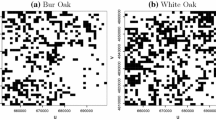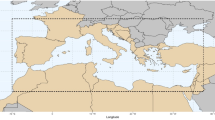Abstract
Modeling the contagious distribution of vegetation and species in ecology and biogeography has been a challenging issue. Previous studies have demonstrated that the autologistic regression model is a useful approach for describing the distribution because patial correlation can readily be accounted for in the model. So far studies have been mainly restrained to the first-orderautologistic model. However, the first-order correlationmodel may sometimes be insufficient as long-range dispersal/migration can play a significant role in species distribution. In this study, we used the second-order autologistic regression model to model the distributions of the subarctic evergreen woodland and the boreal evergreen forest in British Columbia, Canada, in terms of climate covariates. We investigated and compared three estimation methods for the second-ordermodel—the maximum pseudo-likelihood method, the Monte Carlo likeli hood method, and the Markov chain Monte Carlo stochasti capproximation. Detailed procedures for these methods were developed and their performances were evaluated through simulations. The study demonstrates the importance for including the second-order correlation in the autologistic model for modeling vegetation distribution at the large geographical scale; each of the two vegetations studied was strongly autocorrelated not only in the south-north direction but also in the north west-southeast direction. The study further concluded that the assessment of climate change should be performed on the basis of individual vegetation or species because different vegetation or species likely respond differently to different sets of climate variables.
Similar content being viewed by others
References
Albert, P. S., and McShane, L. M., (1995), “A Generalized Estimating Equations Approach for Spatially Correlated Binary Data: Applications to the Analysis of Neuroimaging Data,” Biometrics, 51, 627–638.
Arnold, H. R., (1993), Atlas of Mammals in Britain, London: Her Majesty’s Stationery Office.
—, (1995), Atlas of Amphibians and Reptiles in Britain, London: Her Majesty’s Stationery Office.
Augustin, N. H., Mugglestone, M. A., and Buckland, S. T., (1996), “An Autologistic Model for the Spatial Ditribution of Wildlife,” Journal of Applied Ecology, 33, 339–347.
Besag, J., (1972), “Nearest-Neighbour Systems and the Auto-logistic Model for Binary Data,” Journal of the Royal Statistical Society, Series B, 34, 75–83.
—, (1974), “Spatial Interaction and the Statistical Analysis of Lattice Systems” (with discussion) Journal of the Royal Statistical Society, Series B. 36, 192–236.
—, 1977, “Efficiency of Pseudo Like lihood Estimators for Simple Gaussian Fields,” Biometrika, 64, 616–618.
Box, E. O., Crumpacker, D. W, and Hardin, E. D., (1993), “A Climatic Model for Location of Plant Species in Florida, USA,” Journal of Biogeography, 20,629–644.
Comets, F., (1992), “On Consistency of a Class of Estimators for Exponential Families of Markov Ramdom Fields on the Lattice,” The Annals of Statistics, 20, 455–468.
Diggle, P. J., Fiksel, T., Grabarnik, P., Ogata, Y., Stoyan, D., and Tanemura, M. (1994), “On Parameter Estimation for Pairwise Interaction Point Processes,” International Statistical Review, 62, 99–117.
Diggle, P. J., and Tawn, J. A. (1998), “Model-Based Geostatistics” (with discussion), Applied Statistics, 47, 299–350.
Geyer, C. J. (1994), “On the Convergence of Monte-Carlo Maximum Likelihood Calculations,” Journal of the Royal Statistics Society, Series B, 56, 261–274.
Geyer, C. J., and Thompson, E. A. (1992), “Constrained Monte Carlo Maximum Likelihood for Dependent Data” (with discussion). Journal of the Royal Statistics Society, SeriesB, 54, 657–699.
Gotway, C., and Stroup, W. (1997), “A Generalized Linear Model Approach to Spatial Data Analysis and Prediction,” Journal of Agricultural, Biological and Environmental Statistics, 2, 157–178.
Gu, M. G., and Kong, F. H. (1998), “A Stochastic Approximation Algorithm with Markov Chain Monte Carlo Method for Incomplete Data Estimation Problems,” Proceedings of National Academic Science of USA, 95, 7270–7274.
Gu, M. G., and Zhu, H. T. (2001), “Maximum Likelihood Estimation for Spatial Models by Markov Chain Monte Carlo Stochastic Approximation,” Journal of Royal Statistics Society, Series B, 63, 339–355.
Gumpertz, M. L., Graham, J. M., and Ristaino, J. B. (1997), “Autologistic Model of Spatial Pattern of Phytophthora Epidemic in Bell Pepper: Effects of Soil Variables on Disease Presence,” Journal of Agricultural, Biological and Environmental Statistics, 2, 131–156.
Gumpertz, M. L., Wu, C. T., and Pye, J. M. (1999), “Logistic Regression for Southern Pine Beetle Outbreaks with Spatial and Temporal Autocorrelation,” Forest Science, 46, 95–107.
Houghton, J. T., Jenkins, G. J., and Ephraums, J. J. (1990), Climate Change, the IPCC Scientific Assessment, Cambridge: Cambridge University Press.
Heikkinen, J., and Högmander, H. (1994), “Fully Bayesian Approach to Image Restoration With an Application in Biogeography,” Applied Statistics, 43, 569–582.
Hoeting, J. A., Leecaster, M., and Bowden, D. (2000), “An Improved Model for Spatially Correlated Binary Responses,” Journal of Agricultural, Biological, and Environmental Statistics, 5, 102–114.
Huang, F., and Ogata, Y. (2001), “Comparison of Two Methods for Calculating the Partition Functions of Various Spatial Statistical Models,” The Australian & New Zealand Journal of Statistics, 43, 47–65.
Huffer, F. W., and Wu, H. L. (1998), “Markov Chain Monte Carlo for Auto-logistic Regression Models with Application to the Distribution of Plant Species,” Biometrics, 54, 509–524.
Lamb, H. H. (1977), Climate: Past, Present, and Future. Volume 2. Climatic History and the Future, London: Methuen.
Lenihan, J. M., and Neilson, R. P. (1991), “A Rule-Based Vegetation Formation Model for Canada,” Journal of Biogeography, 20, 615–628.
Little, E. J. Jr. (1971), Atlas of United States Trees, Volume 1–5, Washington, DC: U.S. Government Printing Office.
Mitchell-Jones, A. J., Amori, G., Bogdanowicz, W., Krystufek, B., Reijnders, P. J. H., Spitzenberger, F., Stubbe, M., Thissen, J.B.M., Vohralk, V., and Zima, J. (1999), The Atlas of European Mammals, London: Poyser.
Wu, H., and Huffer, F. W. (1997), “Modelling the Distribution of Plant Species Using the Autologistic Regression Model,” Environmental and Ecological Statistics, 4, 49–64.
Author information
Authors and Affiliations
Corresponding author
Rights and permissions
About this article
Cite this article
He, F., Zhou, J. & Zhu, H. Autologistic regression model for the distribution of vegetation. JABES 8, 205–222 (2003). https://doi.org/10.1198/1085711031508
Received:
Revised:
Issue Date:
DOI: https://doi.org/10.1198/1085711031508




